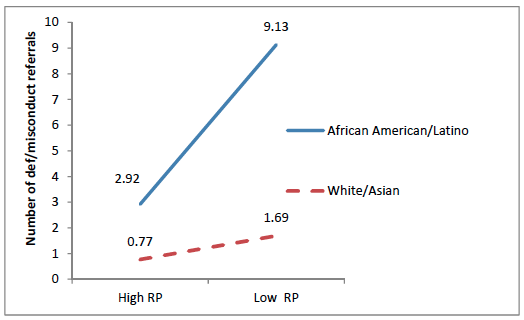The research referenced in this article, "The Promise of Restorative Practices to Transform Teacher-Student Relationships and Achieve Equity in School Discipline," has since been published in the Journal of Educational and Psychological Consultation. Read the abstract and purchase the report.
 On January 8, the U.S. Federal Government issued new guidelines recommending that schools revise their discipline policies to move away from zero tolerance policies, which exclude large numbers of students with suspensions and expulsions, often for minor infractions. Instead the guidelines recommend the use of methods such as restorative practices, which foster positive school climates. A joint effort of the Department of Education and the Department of Justice, these recommendations come in response to numerous studies showing that students of color and students with disabilities are disproportionately impacted by current disciplinary policies, resulting in the creation of what many advocates for change have dubbed a “school-to-prison pipeline.”
On January 8, the U.S. Federal Government issued new guidelines recommending that schools revise their discipline policies to move away from zero tolerance policies, which exclude large numbers of students with suspensions and expulsions, often for minor infractions. Instead the guidelines recommend the use of methods such as restorative practices, which foster positive school climates. A joint effort of the Department of Education and the Department of Justice, these recommendations come in response to numerous studies showing that students of color and students with disabilities are disproportionately impacted by current disciplinary policies, resulting in the creation of what many advocates for change have dubbed a “school-to-prison pipeline.”
Forthcoming study results on restorative practices in schools * , led by Dr. Anne Gregory of Rutgers University, show that restorative practices offer the promise to transform teacher-student relationships and achieve equity in school discipline, thereby narrowing the racial discipline gap. According to Gregory, “A small scale study showed that in classrooms where teachers implemented restorative practices more, they tended to have narrow racial discipline gaps – that is Latino and African-American versus Asian and White students – compared to teachers who implemented RP less frequently (see figure below). Additionally, in classrooms with more restorative practices students tended to experience their teachers as very respectful of them.”
 Teachers above (n = 13) and below (n = 16) the mean on student-perceived RP implementation and number of misconduct/defiance referrals by race/ethnicity (graph reprinted by permission from Taylor & Francis, LLC. http://www.tandfonline.com)The federal guidelines on school climate and discipline have been posted on the Department of Education web site. The recommendations rest upon three guiding principles:
Teachers above (n = 13) and below (n = 16) the mean on student-perceived RP implementation and number of misconduct/defiance referrals by race/ethnicity (graph reprinted by permission from Taylor & Francis, LLC. http://www.tandfonline.com)The federal guidelines on school climate and discipline have been posted on the Department of Education web site. The recommendations rest upon three guiding principles:
- Create positive climates and focus on prevention;
- Develop clear, appropriate, and consistent expectations and consequences to address disruptive student behaviors; and
- Ensure fairness, equity, and continuous improvement. (Guiding Principles: A Resource Guide for Improving School Climate and Discipline, p. 1)
The resource guide makes specific mention of restorative justice under the explanation of the second principle, saying that it can help "students learn from their behaviors, grow, and succeed" (p. 12).
In addition to providing effective responses when incidents of disruption and harm have occurred, restorative practices also offer methods (restorative circles, for example) and a philosophy to give teachers and administrators a framework for working with young people to establish and build respectful relationships. Gregory cautioned, "Like all interventions in schools, restorative practices will likely be more powerful if implemented well." With effective implementation, restorative practices holds the promise to have the kinds of results Gregory and her team observed, including a greater sense of equity and fairness among students and a more positive school and classroom climate, the first and third principles.
Learn more about the IIRP's SaferSanerSchools whole-school change program.
*Gregory A., Clawson, K., Davis, A., & Gerewitz, J. [in press]. The promise of restorative practices to transform teacher-student relationships and achieve equity in school discipline. For a special issue on Restorative Justice in the Journal of Educational and Psychological Consultation.
